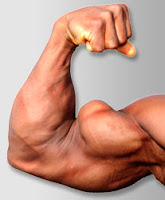"Inner Chest", "Upper Abs", "Biceps Peak" & Co!? Study Finds Proximal and Distal Part of the Triceps Grow Independently and According to Training Stimulus.
 |
| Image 1: Training for the peak, could it be possible, after all? (image from provitamin.in) |
Despite the fact that our movements are always orchestrated by the interplay of a whole host of muscle-groups and -fibers, Wakahara et al.'s results suggest that it may even be possible to target specific parts of individual fibers by selecting the correct exercises. In other words, instead of doing incline bench presses for the upper chest, you could, as many trainers recommend it for years do them with a narrower grip to target the "inner chest", i.e. the inner part of the same muscle fiber that constitutes the "outer chest" (note that this is fundamentally different from training "upper pecs" and "lower pecs", which are in fact separate muscle strands).
The muscle group for which Taku Wakahara and his colleagues were able to show this remarkable effect, was yet not the chest, but the triceps brachii. For their study, the scientists recruited 2x12 healthy young men (25.2 +/- 3.0 years, 172.8 +/- 5.0 cm, 65.3 +/- 7.8 kg; there were 7 dropouts of 19 men who started the 12-week resistance training), who had not participated in a regular resistance training program for the upper extremities for at least 6 months, for a short (single session) and long term (12 weeks) analysis of the effects of DB lying triceps extension on muscular activation and hypertrophy in the triceps brachii.
In the first experiment the scientists had one group of subjects perform 5 sets of 8 repetitions with a 2s concentric and a 2s eccentric phase at 80% of their previously established 1RM-max.
Before and immediately after the resistance exercise, T2-weighted MR images of the upper arm were obtained with an MR scanner [...] The time from completion of the exercise to initiation of the scanning was 72 +/- 21 s. In each MR image, the outline of the triceps brachii muscle was traced to determine the CSA using a software package (Image J, National Institute of Health, USA).In view of the short timespan between the last set of the exercise and the MR scans, we may safely assume, that the CSA (cross-sectional area) increases the scientists measured in this first session were mainly a result of the increased blood-flow to the triceps aka "the pump". For me, this is particularly interesting, because if those areas of the muscles with the "greatest pump", i.e. the greatest increase in CSA immediately after training, would be identical with those areas of the muscle which exhibit the greatest hypertrophy in the course of the 12-week follow-up experiment, this would be evidence for the significance of increased blood flow and "the pump" in view of consecutive muscle growth (it would not, however tell us whether the relation between "the pump" and muscular hypertrophy is corollary or causative!).
 |
| Figure 1: Increases in cross-sectional area of the triceps brachii immediately after a single session of DB lying triceps extensions and a 12-week resistance training protocoll (data calculated based on Wakahara. 2011) |
the region-specific muscle hypertrophy after chronic resistance training is attributable to the regional difference in muscle activation during the exerciseIn other words, the bros at the gym were probably right, there are inner chest, outer chest, biceps peak, upper quads etc. and you can probably train them individually.
In view of the costs of the necessary equipment, it is however not very likely that you will see a "SuppVersity Magneto-Resonance Series" with the "very best exercises for individual parts of each and every muscle fiber as determined by increases in CSA after a single training session" somewhere in the near future. But guess what, in the end you would not even need that if you rely on your own good judgement: If you exercise with heavy weights and proper form, the pump, the burn and the soreness after the workout will tell you if it was the inner chest, or the outer chest that took over the lion's share of your last workout.


